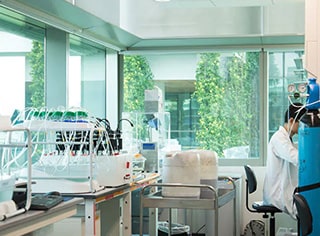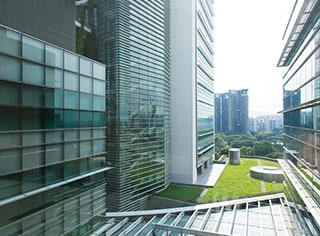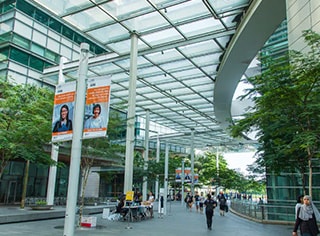Innovation in research, innovation in collaboration

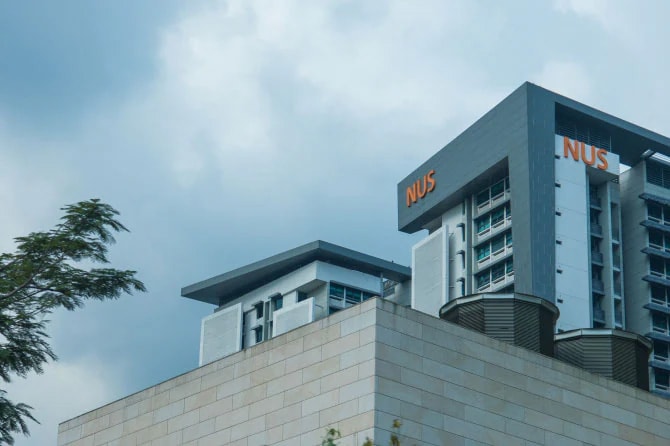
Series: MOMENTUM
Through Shimadzu Innovation Centers, the Shimadzu Corporation not only demonstrates innovation in its commercial products, but also in its approach to research and collaboration

Professor Choon Nam Ong, Director of the National University of Singapore (NUS) Environmental Research Institute, was standing in his laboratory next to a prototype phosphate sensor based on NUS innovation. In the room were a number of visitors who had travelled from Japan to see it. He then guided the visitors to a second identical sensor but for modifications made with Shimadzu engineering. This second sensor, Prof. Ong envisages, would change how nations keep drinking water safe.
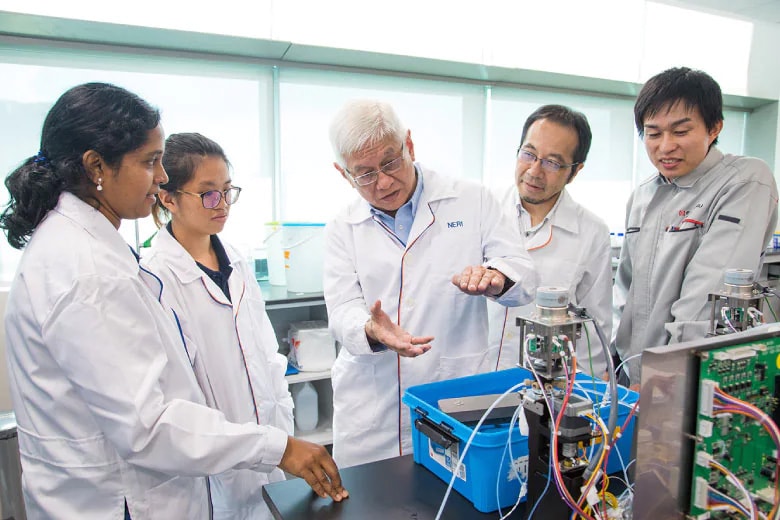
Prof. Choon Nam Ong showcases a Shimadzu prototype based on NUS innovation
Science and Technology for a Better Society
Shimadzu President and CEO Teruhisa Ueda sees the work by Prof. Ong as the next generation of Shimadzu innovation. Everything done at Shimadzu, says Ueda, is based on the company’s corporate philosophy to contribute to society through science and technology. Since its founding in 1875, Shimadzu innovation has brought to Japan, its home country, the first medical x-ray machine, the first photoelectric spectrophotometer and the first gas chromatograph. Today, Shimadzu is making the same impact at a global level.
“Shimadzu has a variety of core technologies. Analytical and measuring instruments, medical systems, aircraft equipment and industrial machinery. Our core technologies are the basis of Shimadzu’s competitiveness,” says CEO Ueda.
However, he realizes that because of the complexity of urgent social challenges, like clean water, the company’s future core technologies will not come from Shimadzu alone.
“We have defined four key areas. Healthcare, infrastructure, environment and energy, and materials. Our plan is to build new products and new technologies that contribute to solving these problems by working with customers and key opinion leaders for new ideas,” he says.
Shimadzu, Singapore, and Water
The challenging issue that Shimadzu aims to solve with the NUS is algal bloom, a global public health concern. Phosphate is a prime nutrient for algal bloom. Runoff from agriculture, sewage and other human activities has caused an extraordinary rise in water phosphate concentration. Cities around the world have seen their drinking water affected. Certain invading algae release highly toxic compounds that contaminate water reservoirs, sometimes leaving water undrinkable. In 2014, the state of Ohio in the U.S.A. declared a State of Emergency that recommended nearly half a million people not to drink their tap water. Current commercial phosphate detection systems can predict where an algal bloom is likely, but they have two key limitations. One is sensitivity. At current sensitivity levels, responders have little time to take countermeasures before the algae flourish. Second is analysis time. The analysis takes days so that the water from which the sample was taken will have moved before the countermeasure is enacted.

Algal bloom has contaminated drinking water throughout the world.
The solution proposed by NUS and Shimadzu combines the use of diffusive gradients in thin films (DGT), a technique used to detect contaminants in water and soil, with Shimadzu’s core technologies for water quality analysis including its Total Organic Carbon (TOC), Nitrous (TN) and Phosphorous (TP) Analyzers. The innovation by NUS replaced the standard solid binding phase in DGT with an aqueous binding phase, allowing for on-site analysis, while Shimadzu’s technologies offer superior sample handling. This combination provides the ability to detect phosphate levels with much higher sensitivity for early detection. The end device NUS and Shimadzu imagine will be one that can measure the phosphate concentration automatically and reliably, and provide on-site monitoring in real time.
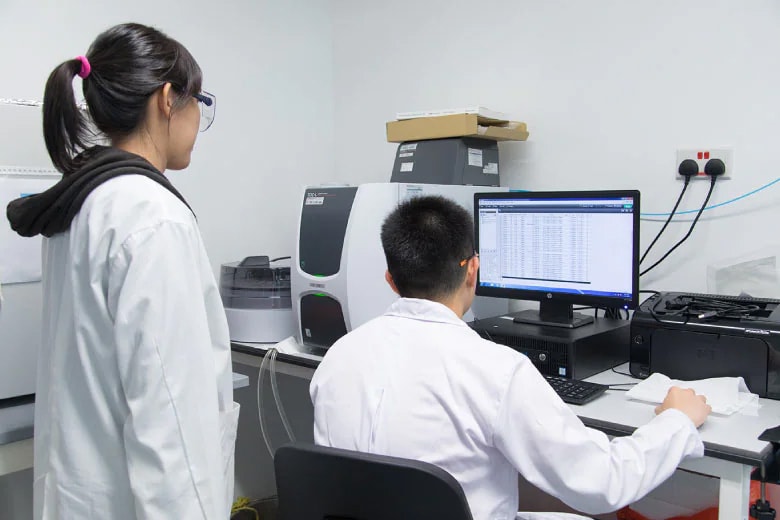
Researchers at NUS using a Shimadzu TOC analyzer
Shimadzu Innovation Centers
This project with the NUS is the result of a new Shimadzu partnership strategy: the Shimadzu Innovation Centers (SIC). The most recent SIC, the Asia Pacific Innovation Centre in Singapore, was opened in 2017 and is managed by Dr. Shin Fujita, one of the Japanese visitors who came to see the NUS phosphate sensor. SICs do not conduct basic research. Rather, they bring together Shimadzu engineers and partners like NUS to build prototypes and ultimately commercial products.
“The mission of the SIC is to create unique products with regional collaborators. Our goal is to cross the Valley of Death. To write a research article, you only need to have two out of ten experiments succeed. To build a commercial product, ten out of ten experiments must succeed. We fill the gaps between journal articles and commercial product,” Dr. Fujita says.
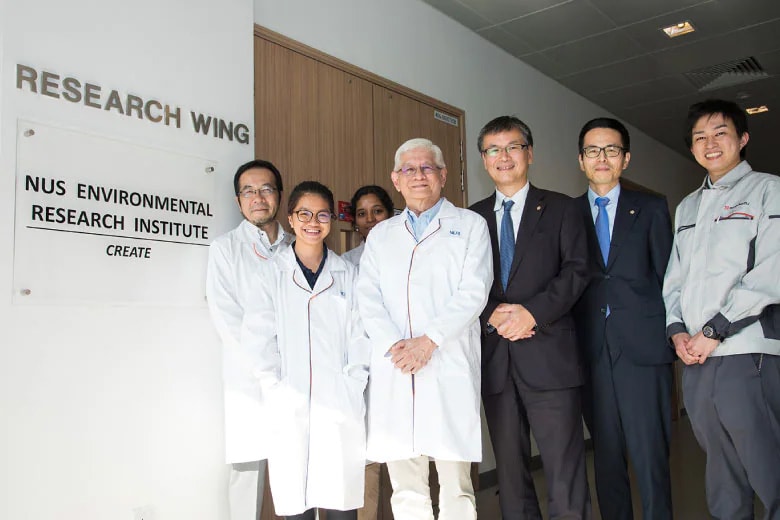
Shin Fujita (far left) and Choon Nam Ong (fourth from left) with other members of ShimadzuCorporation at the NUS Environmental Research Institute.
Other SICs include the first SIC built in the United States in 2014, and two more built in China and Europe. All, says CEO Ueda, share similar objectives, but take different approaches.
“Working with different countries gives new ideas, mentalities, cultures,” he said. Europe tends to focus on application, the U.S. rewards innovation, and China responds to government priorities. “As a result, the thinking at each SIC is different.”
Bringing partners together
Regarding its collaboration with NUS, Shimadzu envisions a portable, wireless, low-cost device that is powered by solar batteries and transmits real-time data to a user’s smartphone. Further, it aims to modify the sensor to detect other water pollutants such as nitrate and arsenic to make an “all-in-one” instrument. This ambitious idea, says CEO Ueda, comes from a new approach of building relationships with Shimadzu customers and partners.
“We have established more than 10-year collaborations with many customers worldwide. We want to grow and our customers to grow. We want to address social challenges by making the best use of our core technologies for research collaborations with customers. In this line, we want partners who think about long-term collaborations.”
SICs are built to strengthen partnerships with Shimadzu customers for faster solutions. As another way to reach faster solutions, CEO Ueda wants to establish the Shimadzu International Laboratory Network, where partners are afforded contact not only with Shimadzu, but also Shimadzu partners. As an example, he cited a collaboration to develop a mass spectrometry system for medical diagnosis support. When partners in other industries heard about it, they too wanted to get involved.
The results of this network were on display last July, when Shimadzu held its first Global Innovation Summit at its headquarters in Kyoto, Japan, welcoming over 100 academic experts on cancer diagnostics, food evaluation, and drug delivery to share their research findings and identify ways in which Shimadzu core technologies can be shared across different research fields.
“Shimadzu is a company that utilizes science and technology for expansion. If we discontinue research and development for science and technology, then Shimadzu will disappear. We have to develop new technologies continuously, which means we have to make investment for the long term. SIC are just one method for our growth in the future,” says CEO Ueda.
Prof. Ong agrees and says that besides focusing on excellent science and technology, Shimadzu’s collaborative efforts through its SICs and other efforts give it an edge over its competitors. “We have found the right partner in Shimadzu to collaborate.”
* The information including affiliates and titles of the persons in this article are current as of the time of interviewing (November 2017).
 Copied
Copied


